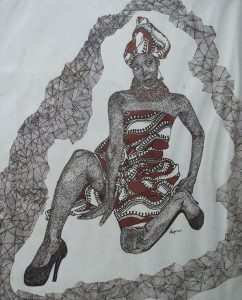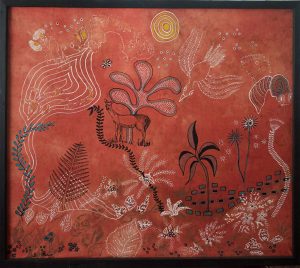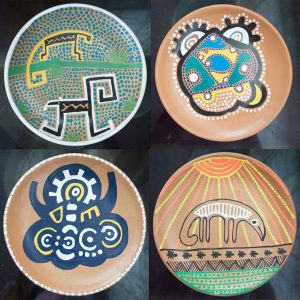
African Queen I
The name Anna Correia-Bevaun is a familiar one in the local art scene. Known in the early stages of her career for the exceptional ceramic work she developed under the guidance of her mother (the late ceramic pioneer Stephanie Correia), she admitted that her start in the creative field was a reluctant one. During a recent interview she explained that while all of her siblings pursued art at varying levels she shared neither their interests nor her mother’s in doing the same.
“I had no intention of doing art in school. My sisters and brothers, most of them did art but I chose to do Food and Nutrition because I wanted to be a nurse. I remember her [Stephanie Correia] going away after she got a scholarship. She went to the [United States of America] and left some pots on the table for us to carve, my sister and myself. I hadn’t any interest in that. I did one and my sister did all the rest.”
It wasn’t until she was six months pregnant with her second child that she considered the possibility of pursuing art as a career that would allow her to work from home while she took care of her children. And it was through the suggestion of her mother that she decided to take up ceramics in particular.

Anna Correia-Bevaun
“She brought a ceramic plate and asked, ‘Well, you want to do ceramics?’ And that’s how I got started in 1988. I started to do work with clay and then she gave me a crash course in hand building, how to roll out and do things with coils etc. That’s how I got started.”
A few years later, again through the prompting of her mother, Correia-Bevaun would take yet another decisive step in her art career by joining a local artist-led initiative established to nurture the creative practices of Guyanese women. She explained that as she produced her ceramic pieces her mother began showing them alongside her own work at various exhibitions.
“In 1995 when she left to go to Canada for the second time she said, ‘Anna why don’t you join the women artists?’ At that time Marjorie Broodhagen was the president and they had their exhibition at Castellani House for the first time. I worked a lot on small pieces but I would also do a big piece. So by the end of the year I had enough to show at the exhibition. And that’s how I joined the [Guyana Women artists’ Association].”
Correia-Bevaun had a prolific career in ceramics for a number of years but it was the discovery of her broken kiln in 2000 that ultimately led her away from clay and towards a different medium entirely. After the passing of her mother that same year she came across some of her watercolour paints and three empty watercolour notepads. A few years later, equipped with those materials and the will to master the techniques, she registered for a twelve-week watercolour course taught by the renowned Cuban-born artist Josefa Valz at the National Gallery of Art.

the Bottom of the Mountain
“When I got there she [Valz] assumed that everyone knew how to draw. I told her that I drew from pictures but I never drew from a model. I wasn’t taught how to draw. I just started by looking at pictures that I liked and drawing from that.”
As time went by Correia-Bevaun continued exhibiting annually with GWAA while developing her drawing skills, particularly in the pen and ink medium. She practiced arranging her own compositions by using clippings from various sources, another technique she learned from her mother and developed even futher.
Eventually she turned her focus to the Biennial National Watercolour Competitions hosted by the National Art Gallery, Castellani House. After finding out about the gallery’s 2007 competition she decided it was time to work on three paintings for consideration by members of the jurying committee.
“I wasn’t expecting to win anything. Then they called me and told me that I won two medals, the silver and bronze. I entered again in 2009 with three paintings and then they told me I got gold and silver.”

While her outstanding skills in watercolour have been recognized and rewarded over the years, Correia-Bevaun admits that her preference is pen and ink since it allows her to work faster. “If you’re doing watercolour it would take you about five or six days to finish because you’re working it over and over and you have to leave it to dry before you could go back to it again.”
Nevertheless, she continues to explore the possibilities of each medium whether watercolours, pen and ink, pencil crayons, or even the occasional design work on ready-made ceramic plates.
When asked about the balancing act between her responsibilities, work commitments and her art production she reiterated the importance of time management and the willingness to make sacrifices in order to get those things done.

“I work better under pressure. If I have a deadline to get something done then I would persevere. I used to see my mother getting up early in the mornings to paint because she had her home and children to look after. So over the years that’s how I did it. When you’re younger you could work in the night when everyone’s asleep. Now it’s harder to work and see properly in the night. But if you want to do it then you have to persevere.”
Inspired by her mother’s principles, Correia-Bevaun’s credits her continued success to the centrality of her faith. “God must always be in the picture and he must always come first. Pray before you do something and after you do it so that He will bless the work you’re doing. That’s what I’ve been doing for all these years.”




.png)









